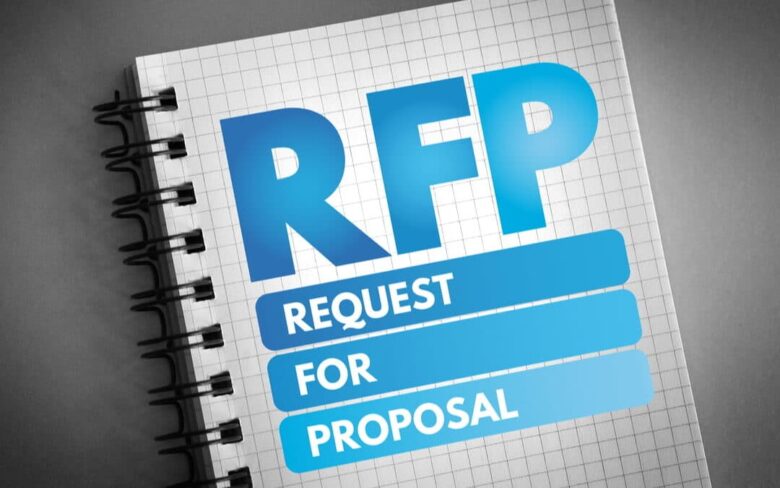When it comes to sourcing vendors or services for a project, a well-executed Request for Proposal (RFP) can make all the difference. This defined process for soliciting proposals via a competitive bidding process not only ensures a fair selection process, but it can facilitate project management, improve outcomes, and build credible business relationships. Understanding the process, the critical elements, steps to streamline, and ensuring efficacy and efficiency can ensure you make the most out of it. In this article, we explore these components in-depth.
The Importance of a Robust RFP Process

Alt text: Person using laptop for the RFP process
A robust RFP process is the foundation for a successful project outcome. A well-defined process provides a systematic way to express project requirements, solicit proposals, and identify potential vendors who can deliver the required services or products.
A strong RFP offers clarity and transparency, providing all potential vendors with the same information simultaneously. This fair and open communication fosters trust, encourages competitive proposals, and often leads to better-quality bids.
Moreover, a well-executed RFP process ensures objectivity in vendor selection by focusing on defined criteria instead of subjective preferences. It also enables better negotiation of terms, resulting in a more advantageous contract for the organization.
One of the significant components in the RFP journey is to understand the RFP process. The more you know, the more efficient and beneficial the request for proposal process becomes for your organization.
The Key Elements of a Successful RFP
The success of an RFP largely depends on its key elements. These include a clear statement of the project requirements, a detailed specification of services or products required, and the evaluation criteria used to select the vendor.
A successful RFP should also include a timeline for response, a template for responses to ensure consistency in evaluation, and a clear description of the contract terms. It should also specify the type of relationship the organization wishes to establish with the vendor.
Transparency is an essential aspect of a successful RFP. It helps ensure that potential vendors fully understand project requirements and expectations, reducing the risk of misunderstanding or misinterpretation.
Finally, a successful RFP presents a win-win opportunity for both parties, fostering a sense of partnership and collaboration rather than a mere transaction.
Steps for Streamlining Your RFP Process

Streamlining your RFP process can save time, reduce errors, and increase the effectiveness of the process. The first step towards streamlining is developing a standard template for your RFPs. This template should cover all the significant aspects of the project and provide guidelines on how to submit proposals.
Another step is to automate as much as possible. Utilize technology to distribute RFPs, receive responses, and conduct evaluations. This step not only saves time but also reduces the chance of human error.
Streamlining also involves creating a comprehensive evaluation process to analyze proposals. This process should be objective, fair, and consistent to select the best vendor for the project.
Lastly, offer clear and constructive feedback to unsuccessful vendors. This practice can lead to improved proposals in the future and maintain good relationships with vendors.
Legal and Compliance Considerations
The RFP (Request for Proposal) process must strictly adhere to legal regulations and organizational policies. This adherence is not merely about abiding by the law; it’s about ensuring fairness, transparency, and ethical practices in the procurement process. Legal and compliance factors play a significant role in vendor selection and contract negotiations. Organizations need to be aware of various laws, including those related to procurement, data protection, and industry-specific regulations. Compliance becomes especially critical when dealing with international vendors, as cross-border legal complexities may arise. During contract negotiations, legal teams should review terms and conditions to ensure they align with both legal requirements and organizational standards. This careful scrutiny helps prevent potential legal disputes and ensures that vendor relationships are built on a solid, compliant foundation.
Budget and Cost Control

Budget considerations are a cornerstone of the RFP process. Setting clear budget expectations and evaluating proposals against these constraints is crucial for financial discipline and resource allocation efficiency. This step involves a detailed analysis of the total cost of ownership, including not just the initial investment but also long-term costs like maintenance, upgrades, and support. Proposals should be assessed not only for their technical or service capabilities but also for their cost-effectiveness and value proposition. A well-defined budget helps in avoiding overspending and ensures that the selected vendor offers the best combination of price and performance. This approach promotes financial sustainability and strategic spending in line with organizational goals.
Risk Assessment and Mitigation
Conducting risk assessments when evaluating RFP responses is essential to safeguard an organization against potential pitfalls. This involves identifying and analyzing the risks associated with each vendor’s proposal, including financial stability, compliance risks, delivery timelines, and potential for service disruptions. Strategies for mitigating these risks include requiring vendors to provide detailed contingency and business continuity plans, conducting thorough background checks, and insisting on compliance with industry standards. It’s also crucial to have clear contract terms that outline the responsibilities and liabilities of each party. By proactively identifying and mitigating risks, organizations can ensure more stable and reliable vendor relationships.
Diversity and Inclusion
Promoting diversity and inclusion in vendor selection is increasingly becoming a priority for organizations. This commitment is not just a moral imperative but also brings in diverse perspectives and innovation. In the RFP process, this can involve setting diversity goals, such as encouraging proposals from minority-owned, women-owned, or small businesses. Organizations may also evaluate vendors based on their own diversity and inclusion policies. Incorporating these considerations into the RFP process can help foster a more inclusive business ecosystem and reflect an organization’s commitment to social responsibility.
Scalability and Future Planning

Incorporating scalability into the RFP process is crucial, particularly for projects that are expected to grow or evolve over time. Scalability refers to the ability of a solution or service to expand or adapt in response to changing needs or increased demands. When evaluating proposals, it’s important to consider not only the current requirements but also how well the vendor can accommodate future growth or changes. This foresight can lead to more flexible, cost-effective, and long-term vendor relationships. Vendors who demonstrate an ability to scale their services in line with an organization’s growth can provide significant advantages, ensuring that as the organization evolves, its partnerships can adapt and grow in tandem.
RFP Process: Ensuring Efficacy and Efficiency
Alt text: Business meeting for development team to discuss the RFP process
The request for proposal process can be both efficient and effective with careful planning and execution. To ensure efficacy, it’s crucial to begin with a clear understanding of what the organization needs from a vendor. This understanding then guides the writing of the RFP and the evaluation of the responses.
To increase efficiency, standardize and automate the process wherever possible. However, don’t lose sight of the inherent value of human judgment in the process. While automation can save time and reduce errors, the ultimate decision should be guided by human expertise and insight.
Continuous improvement is crucial in ensuring the long-term success of the request for proposal process. Take time to reflect on past RFPs and use those insights to refine and enhance the process.
Finally, remember that the request for proposal process is not just about selecting a vendor. It is more about building relationships. A successful RFP process fosters collaboration, partnership, and mutual success between the organization and the vendor.
Overall, understanding the request for proposal process is essential for its successful execution. A robust process, clear RFP, streamlined steps, avoidance of common pitfalls, and ensuring efficacy and efficiency can turn this task into a strategic tool that delivers significant value.

